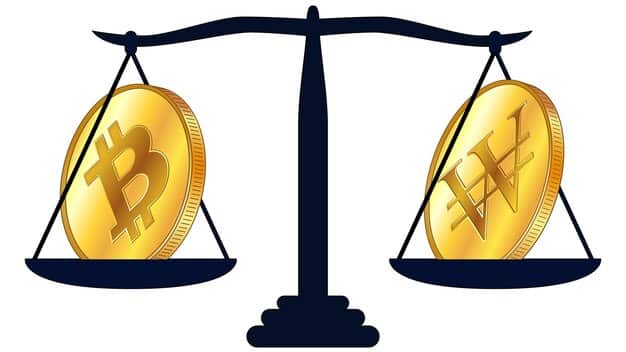Altcoin Portfolio Diversification: Balancing Risk and Reward

Altcoin portfolio diversification involves strategically allocating investments across various alternative cryptocurrencies to mitigate risk and enhance potential returns in a volatile market.
Navigating the world of cryptocurrencies can feel like traversing a minefield, especially when it comes to altcoins. Smart **altcoin portfolio diversification** is not just about spreading your investments; it’s a strategic approach to balancing risk and reward in this highly volatile market.
Understanding the Altcoin Market and Its Volatility
The altcoin market, characterized by its high growth potential and equally high risk, demands a nuanced understanding before diving in. Recognizing the inherent volatility is the first step towards making informed investment decisions.
Altcoins, or alternative cryptocurrencies, can offer significant opportunities for profit, but they also come with unique challenges. It’s crucial to understand the factors that drive their price fluctuations and how to manage the associated risks.
Factors Contributing to Altcoin Volatility
Several factors contribute to the volatility of the altcoin market. These include market sentiment, technological advancements, regulatory changes, and adoption rates.
- Market Sentiment: News, social media trends, and investor opinions can heavily influence altcoin prices.
- Technological Advancements: Developments in blockchain technology and specific altcoin projects can lead to price surges or declines.
- Regulatory Changes: Government regulations and legal frameworks can have a substantial impact on the perceived value and usability of altcoins.
- Adoption Rates: The level of acceptance and use of an altcoin by businesses and individuals directly affects its demand and price.
Understanding these factors is essential for recognizing potential risks and opportunities within the altcoin market.

In conclusion, the altcoin market presents both exciting opportunities and considerable challenges. A thorough understanding of its volatility and the factors that drive it is vital for successful altcoin portfolio diversification.
The Importance of Diversification in Cryptocurrency Investments
Diversification is a cornerstone of sound investment strategy, and it’s especially critical in the cryptocurrency market. By spreading your investments across different assets, you can reduce the impact of any single asset’s poor performance.
In the context of cryptocurrencies, diversification means investing in a variety of altcoins, each with different features, use cases, and market capitalizations. This approach helps to mitigate risk and potentially increase overall returns.
Why Diversify Your Altcoin Portfolio?
Diversifying your altcoin portfolio offers several key benefits, including risk reduction, increased potential for returns, and exposure to different sectors within the cryptocurrency ecosystem.
Conversely, concentrating your altcoin investments carries substantial risk. Below are points highlighting the inherent danger:
- Reduced Risk: Spreading investments minimizes the impact of a single altcoin’s failure or underperformance.
- Increased Potential for Returns: Different altcoins may perform well at different times, increasing the likelihood of capturing gains.
- Exposure to Different Sectors: Diversification allows you to invest in various areas of the cryptocurrency market, such as decentralized finance (DeFi), non-fungible tokens (NFTs), and layer-2 scaling solutions.
Diversification serves as a safety net, ensuring that your entire portfolio isn’t wiped out by the downfall of a single asset.
By understanding the importance of altcoin portfolio diversification, investors can make more informed decisions that align with their risk tolerance and investment goals.
Strategies for Effective Altcoin Portfolio Diversification
Effective altcoin portfolio diversification requires a well-thought-out strategy that considers various factors, including risk tolerance, investment goals, and market conditions. Different approaches can be employed to achieve optimal diversification.
One popular strategy is to allocate investments based on market capitalization, focusing on a mix of large-cap, mid-cap, and small-cap altcoins. Another approach involves diversifying across different sectors within the cryptocurrency market.
Approaches to Altcoin Diversification
There are several effective strategies for diversifying your altcoin portfolio. These include market capitalization allocation, sector diversification, and geographic diversification.
The core goal here is to construct a portfolio of altcoins that can withstand market fluctuations. The elements to consider include:
- Market Capitalization Allocation: Investing in a mix of large-cap, mid-cap, and small-cap altcoins to balance stability and growth potential.
- Sector Diversification: Spreading investments across different sectors of the cryptocurrency market, such as DeFi, NFTs, and layer-2 solutions.
- Geographic Diversification: Considering altcoins from different regions and countries to mitigate regulatory and economic risks.
By employing these strategies, investors can create a more resilient and potentially profitable altcoin portfolio.
In summary, effective altcoin portfolio diversification involves careful planning and a deep understanding of the cryptocurrency market. Choosing the right strategies can significantly enhance your investment outcomes.

Assessing Risk Tolerance and Investment Goals
Before diving into altcoin portfolio diversification, it’s essential to assess your risk tolerance and define your investment goals. Understanding your personal risk appetite and objectives will guide your diversification strategy.
Risk tolerance refers to your ability to withstand potential losses in your investments. Investment goals, on the other hand, define what you hope to achieve with your investments, such as long-term growth, passive income, or capital preservation.
Understanding Your Risk Tolerance
Assessing your risk tolerance involves evaluating your financial situation, investment experience, and emotional response to market volatility. A conservative investor may prefer lower-risk altcoins, while an aggressive investor may be comfortable with higher-risk, higher-reward options.
Here are a few points to keep in mind when performing a self-assessment:
- Financial Situation: Consider your income, expenses, and savings to determine how much risk you can afford to take.
- Investment Experience: Reflect on your past investment successes and failures to understand your comfort level with different levels of risk.
- Emotional Response: Assess how you react to market downturns and whether you tend to make impulsive decisions based on fear or greed.
By carefully evaluating your risk tolerance, you can tailor your altcoin portfolio diversification strategy to suit your individual needs.
In conclusion, understanding your risk tolerance and defining your investment goals are crucial steps in creating a successful and sustainable altcoin portfolio.
Researching and Selecting Altcoins for Your Portfolio
Thorough research is paramount when selecting altcoins for your portfolio. Don’t rely on hype or speculation; instead, focus on understanding the fundamentals of each project and its potential for long-term growth.
Look for altcoins with strong teams, innovative technology, real-world use cases, and active communities. Evaluate their market capitalization, trading volume, and historical performance before making any investment decisions.
Key Factors to Consider When Researching Altcoins
When researching altcoins, consider the following key factors: team and development, technology and use case, market capitalization and trading volume, and community and adoption.
- Team and Development: Assess the experience and expertise of the project team and their track record of delivering on promises.
- Technology and Use Case: Evaluate the underlying technology of the altcoin and its potential to solve real-world problems or disrupt existing industries.
- Market Capitalization and Trading Volume: Consider the market capitalization and trading volume of the altcoin, as these factors can indicate its liquidity and stability.
- Community and Adoption: Look for altcoins with active and engaged communities, as well as increasing levels of adoption by businesses and individuals.
By conducting thorough research, you can identify promising altcoins with the potential to generate significant returns.
To summarize, informed decision-making in selecting altcoins is vital for successful altcoin portfolio diversification. Always prioritize fundamental analysis over speculation to maximize your chances of success.
Monitoring and Rebalancing Your Altcoin Portfolio
Once you’ve created your diversified altcoin portfolio, it’s essential to monitor its performance regularly and rebalance as needed. Market conditions and individual altcoin performance can change over time, affecting your portfolio’s overall risk and return profile.
Monitoring involves tracking the prices of your altcoins, analyzing market trends, and staying informed about any news or developments that could impact your investments. Rebalancing involves adjusting your portfolio’s asset allocation to maintain your desired level of diversification.
Best Practices for Monitoring and Rebalancing
To effectively monitor and rebalance your altcoin portfolio, follow these best practices: set clear goals, track performance metrics, stay informed, and rebalance periodically.
Remember, consistent action is the best action when it comes to overseeing your altcoin investments:
- Set Clear Goals: Define your target asset allocation and risk tolerance to guide your monitoring and rebalancing efforts.
- Track Performance Metrics: Monitor key performance indicators (KPIs) such as returns, volatility, and correlation between altcoins.
- Stay Informed: Keep up-to-date with news, trends, and developments in the cryptocurrency market to make informed decisions.
- Rebalance Periodically: Review and adjust your portfolio’s asset allocation at regular intervals (e.g., quarterly or annually) to maintain your desired level of diversification.
By following these best practices, you can optimize your altcoin portfolio diversification strategy and achieve your investment goals.
In conclusion, continuous monitoring and strategic rebalancing are key components of a successful altcoin investment strategy. Adapting to market changes ensures your portfolio remains aligned with your goals and risk tolerance.
| Key Point | Brief Description |
|---|---|
| ⚖️ Risk Assessment | Evaluate your risk tolerance before investing. |
| 🔎 Research | Thoroughly research altcoins’ fundamentals. |
| 📊 Diversification | Spread investments across various altcoins. |
| 🔄 Rebalancing | Regularly adjust your portfolio allocation. |
Frequently Asked Questions
▼
Altcoin portfolio diversification is the strategy of spreading your investments across multiple alternative cryptocurrencies to reduce risk and increase potential returns. It prevents reliance on a single asset’s performance.
▼
Diversification minimizes the impact of any single altcoin’s underperformance on your overall portfolio. It also provides exposure to different growth opportunities within the cryptocurrency market, enhancing potential gains.
▼
Evaluate your financial situation, investment experience, and emotional response to market volatility. Conservative investors may prefer lower-risk altcoins, while aggressive investors might opt for higher-risk, higher-reward options.
▼
Consider the team and development, technology and use case, market capitalization and trading volume, and community and adoption. Thorough research prevents investments based on hype rather than fundamentals.
▼
Rebalance your portfolio periodically, such as quarterly or annually, to maintain your desired asset allocation and risk level. Adjust your allocations based on market changes and personal investment goals.
Conclusion
Altcoin portfolio diversification is a critical strategy for navigating the volatile cryptocurrency market, offering a balanced approach to mitigate risk while maximizing potential returns. By understanding market dynamics, assessing risk tolerance, conducting thorough research, and consistently monitoring and rebalancing your portfolio, you can position yourself for success in the dynamic world of altcoin investing.





